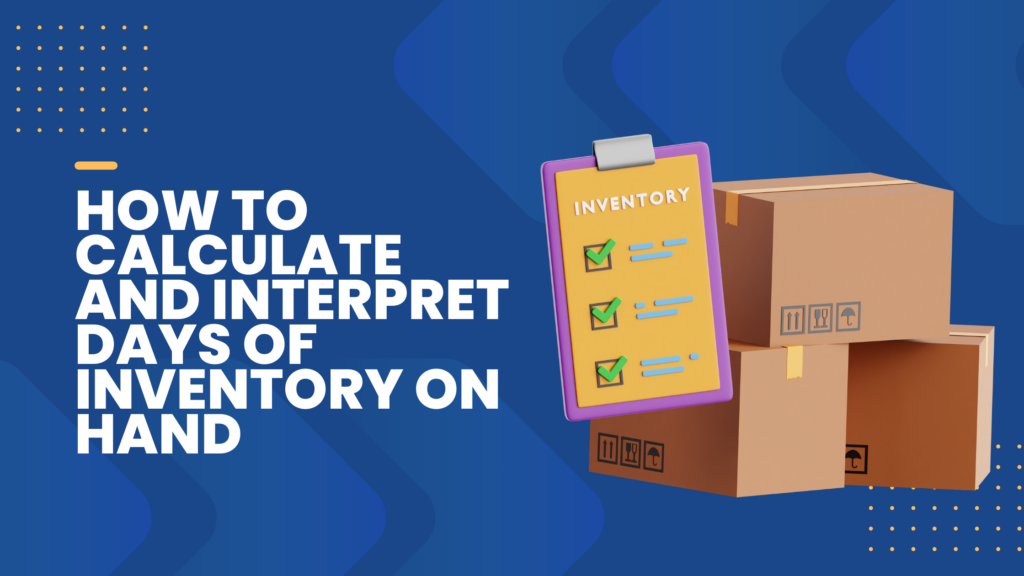How to Calculate and Interpret Days of Inventory on Hand
What Is Inventory Days on Hand?
Inventory Days on Hand is a measurement that indicates how many days it takes for a business to sell through its stock of inventory. This metric is commonly used by financial analysts, investors, and merchants to assess how efficiently a business manages its inventory dollars.
By calculating the number of days it takes to sell inventory, merchants can make short-term projections, set reorder points, and ensure a smooth flow of inventory through the procurement and sales process. Since inventory is typically a merchant’s largest investment, understanding inventory days on hand is crucial for assessing how long capital is tied up in inventory.
Calculating Inventory Days on Hand
There are two main methods to calculate inventory days on hand:
Method 1: Average Inventory / (Cost of Goods Sold (COGS) / Days in the Accounting Period)
The first method involves dividing the average inventory by the cost of goods sold (COGS) divided by the number of days in the accounting period. The formula for this method is as follows:
Average Inventory / (COGS / Days in the Accounting Period) = Inventory Days on Hand
To calculate the average inventory, add the beginning inventory and ending inventory (found on your balance sheet) and divide by 2. Let’s assume that your accounting period is a full calendar year (365 days). If your average inventory is $50,000 and your COGS over the last 365 days was $250,000, the formula would look like this:
50,000 / (250,000 / 365) = ~73 days of inventory on hand
Method 2: Days in the Accounting Period / Inventory Turnover Ratio
The second method, known as the Inventory Turnover method, requires the calculation of the inventory turnover ratio. The inventory turnover ratio, a common example of fractions or ratio calculations, represents the number of times a business sells through its inventory on hand within a given period of time.
The formula for calculating inventory days on hand using the inventory turnover method is as follows:
Days in the Accounting Period / Inventory Turnover Ratio = Inventory Days on Hand
Returning to the example above, if you sold through your inventory 5 times in the past year, you would divide 365 by 5:
365 / 5 = 73 days on hand
Both methods yield the same results, so choose the one that aligns with the variables available from your ledger.
The Importance of Shortening Inventory Days on Hand
Maintaining a low inventory days on hand is beneficial for several reasons:
1. Increased Capital for Business Investment
Inventory is often a merchant’s largest investment and can tie up a significant amount of capital. By reducing inventory days on hand, businesses free up capital that can be reinvested in other areas of the business, such as product development, marketing, or expansion.
2. Agility in Responding to Consumer Demand
Having more capital on hand allows businesses to respond quickly to changing consumer demand. With the ability to invest in new product lines or jump on hot trends before competitors, businesses can stay ahead of the curve and meet customer expectations.
3. Decreased Risk of Obsolescence
Obsolete inventory, which can no longer be sold due to lack of demand or relevance in the market, can be a drain on resources. By reducing inventory days on hand, businesses can minimize the risk of carrying excess inventory and increase the chance of selling products before they become obsolete.
4. Decreased Inventory Carry Costs
Storing, transporting, and managing inventory can incur costs, especially when inventory needs to be stored long-term. By shortening inventory days on hand, businesses can reduce these carry costs and improve overall profitability.
Strategies to Avoid Slow-Moving Inventory
 To reduce inventory days on hand and ensure efficient inventory management, consider implementing the following strategies:
To reduce inventory days on hand and ensure efficient inventory management, consider implementing the following strategies:
1. Partner with a Fulfillment Provider
Collaborate with a fulfillment provider that can leverage your sales history to forecast demand and make recommendations for order times and quantities. By working with a fulfillment expert, you can optimize your inventory levels and minimize excess inventory.
2. Distribute Inventory Strategically
Consider distributing inventory to locations where there is high demand. According to McKinsey, distributing slow-moving inventory to areas where it is in demand can help reduce inventory days on hand and improve overall inventory management.
3. Bundle Products Together
If you have a slow-moving item, consider bundling it with a high-velocity product to increase sales. Offering the slow-moving item as an accessory or complimentary item can help stimulate demand and reduce inventory days on hand. Consider making suggestions for bundled products at checkout or offering them as kits.
By adopting these strategies, businesses can optimize their inventory management, reduce inventory days on hand, and improve cash flow. However, it’s important to strike a balance and consider the risks associated with carrying too little inventory. Stockouts and missed sales opportunities can occur if inventory levels are too low.
These inventory management principles also apply to industries like auto repair, where having the right parts on hand is crucial to avoid repair delays. Shops can benefit from automotive inventory management software that tracks parts orders, automates reordering, and helps reduce excess stock.
How Can Inventory Source Help
Inventory Source, a UPS-backed fulfillment partner, offers comprehensive solutions to help businesses optimize their inventory management. With a fully-integrated WMS, TMS, and OMS platform, Inventory Source enables merchants of all sizes to monitor their inventory levels across all sales channels and fulfillment locations.
Through its integrated inventory management system, Inventory Source provides real-time notifications when inventory levels are low, offering estimated days on hand and suggesting reorder points. By leveraging Inventory Source’s industry-leading SLAs, merchants gain peace of mind knowing that they are making informed decisions about procurement.
If you’re looking for a fulfillment partner to help you optimize your inventory and streamline your operations, reach out to one of Inventory Source’s fulfillment specialists today.
Conclusion
Efficient inventory management is essential for the success of any retail or ecommerce business. Calculating and monitoring inventory days on hand allows businesses to gain insights into their inventory performance, turnover, and liquidity. By shortening inventory days on hand, businesses can free up capital, respond quickly to consumer demand, reduce the risk of obsolescence, and decrease inventory carry costs.
Implementing strategies such as partnering with a fulfillment provider, distributing inventory strategically, and bundling products together can help businesses optimize their inventory management and improve overall profitability. With the support of Inventory Source’s comprehensive solutions, businesses can streamline their operations and achieve efficient inventory management.
Optimize your inventory management today and unlock the potential for growth and success in your retail or ecommerce business.




